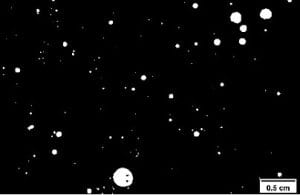To assure the frost resistance of conventional concretes, it is necessary to quantify its air void structure. The most widely used method for measuring air void parameters in hardened concretes are the microscopy-based methods outlined in ASTM C457/457M-16. This standard sets out three test procedures to perform microscopical determinations of the air content of hardened concrete, as well as the specific surface, void frequency, spacing factor, and paste-air ratio of the air-void system in hardened concretes. The three procedures as detailed in the standard are the linear-traverse method (Procedure A), the modified point-count method (Procedure B), and the contrast enhanced method (Procedure C). Both Procedures A and B can be conducted manually, but this is time-consuming, tedious, and expensive, with results influenced by operator judgment and experience. To address these drawbacks, the contrast-enhanced method has been developed to identify air voids using image analysis. Once air-void images are acquired, color enhancement needs to be performed on the sample before conducting a microscopy analysis. This color enhancement process requires significant effort, cost, and time for sample preparation, is labor intensive, and the resulting quality of the surface treatment can influence the accuracy of test results.


(a) Overview air-void analysis system (b) Overall image capturing system

(c) LED lights setup
Fig 1. Hardware sub-system of automated air-void segmentation system
In an effort to improve upon the effectiveness of ASTM C457/457M-16, Procedure C, STIM Lab has developed a prototype, fully automated air-void segmentation system for use in hardened concrete analysis. STIM Lab built an automated air-void segmentation system employing 3D photometric reconstruction and image segmentation techniques for air void analysis in hardened concretes. As designed and tested, the system is composed of 3D reconstruction hardware and data collection/data processing software subsystems. The hardware system includes a high-resolution CCD (Charge Coupled Device) Sony camera, an LED system incorporating six LED lights, and a computer. The software component includes the 3D reconstruction computer and image processing and deep learning algorithms for automatic segmentation of concrete air-voids. The primary application of the system is to perform air-void analysis in accordance with the ASTM C457, Procedure C. As used in this system, the CCD camera has a resolution of 42 megapixels and can capture a high-resolution image of 5.6 μm/pixel of the concrete, identifying air voids with a minimum diameter of between 10-22 μm. This study has resulted in 2 journal publications, 2 conference presentations, and 1 patent application.


(a) Original concrete surface image (b) Mapped 3D surface image

(c) Segmented concrete surface image
Fig 2. Output of the developed system from different steps